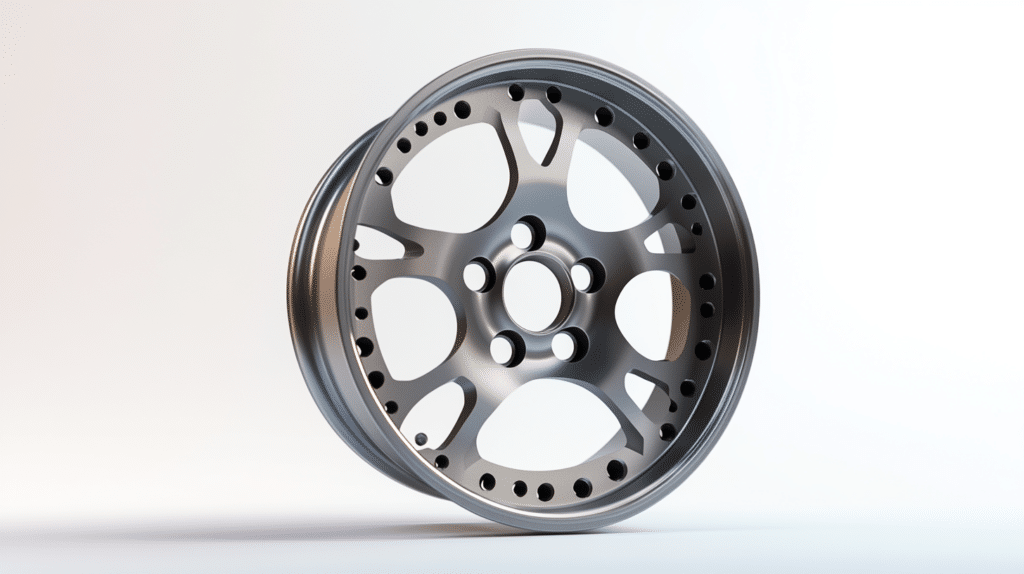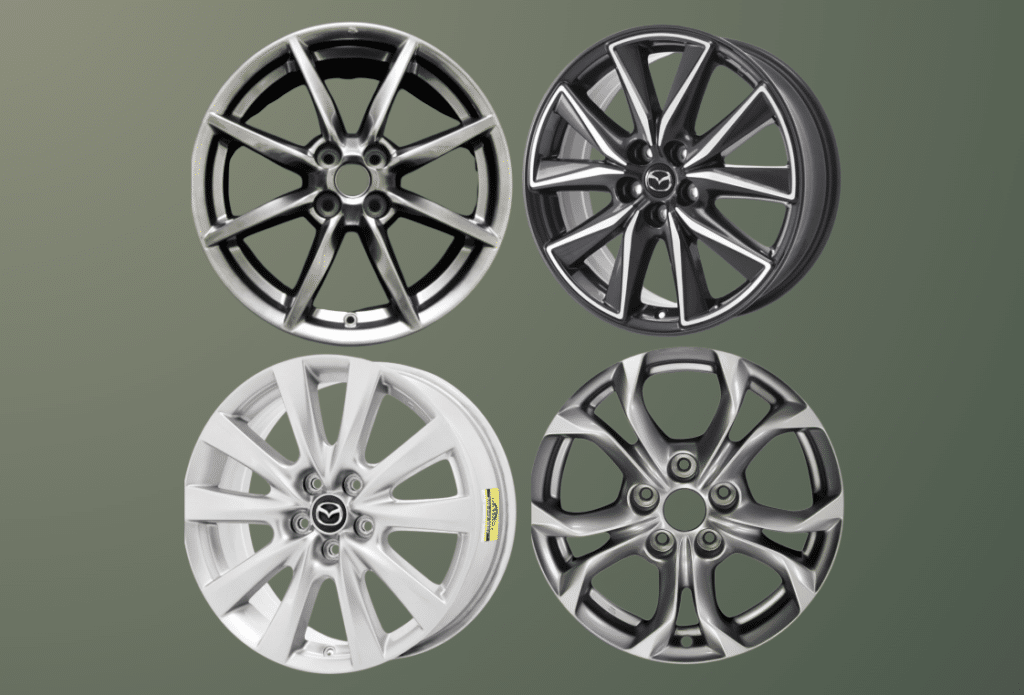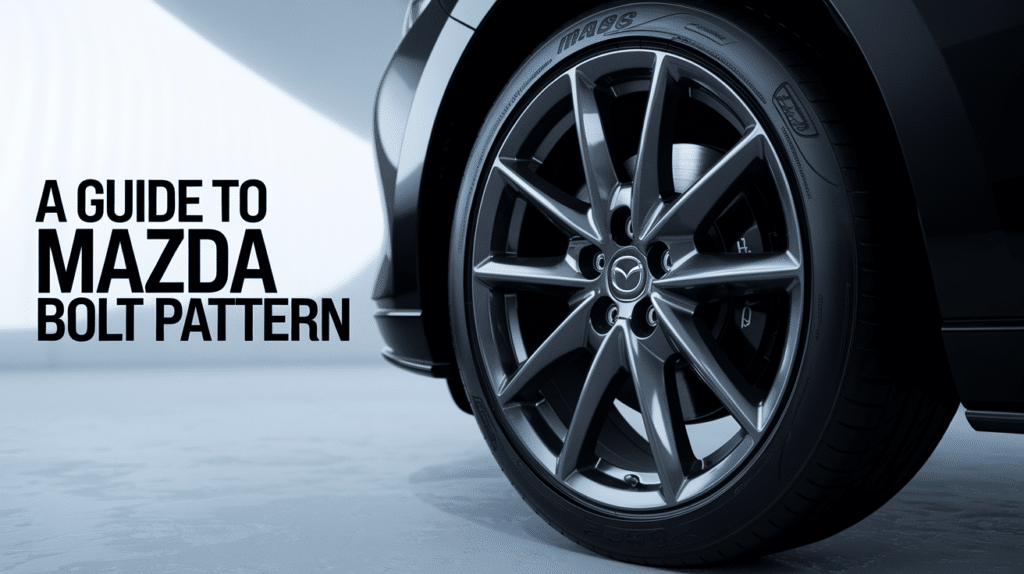Are you stuck trying to find the right wheels for your Mazda?
I know how hard it can be to figure out bolt patterns – I’ve been there, too. Picking the wrong size means wasted time and money, not to mention the hassle of returns.
The good news? I’ve put together a simple guide that breaks down everything about Mazda bolt patterns.
You’ll learn exactly what to look for when shopping for new wheels, understand the measurements, and pick the perfect fit for your specific model.
Ready to become an expert on your Mazda’s bolt pattern? Let me walk you through it step by step.
What Is the Bolt Pattern for A Mazda?

But first, what is a bolt pattern?
The bolt pattern refers to the arrangement of lug holes on the wheel, forming an imaginary circle that determines compatibility with the vehicle’s hub.
The bolt pattern is typically described in a two-number format.
For example, “5×114.3” signifies the following:
- The first number, “5,” indicates the number of bolt holes.
- The second number, “114.3,” represents the diameter of the imaginary circle formed by the bolt holes, measured in millimeters.
For most Mazda models, the bolt pattern commonly used is 5×114.3, but variations exist depending on the specific model and production year.
Checking the vehicle’s specifications or consulting a fitment expert can provide precise information.
Understanding Mazda Bolt Patterns and Their Compatibility
Understanding bolt patterns is crucial when it comes to ensuring the perfect fitment of wheels on your Mazda vehicle.
Importance of Mazda Bolt Patterns
Mazda bolt patterns are more than just technical details. They play a vital role in:
- Safety: Secure attachment of wheels minimizes accident risks.
- Performance: Proper alignment and stability improve handling and braking.
- Compatibility: Ensures aftermarket or replacement wheels fit without issues.
Common Mazda Bolt Patterns
- Most Mazda models use the 5×114.3 bolt pattern, which is widely compatible with wheels from various brands.
- However, some older or niche Mazda models may have different patterns.
- Always verify your Mazda’s model and year before purchasing new wheels.
Key Compatibility Considerations
When selecting wheels for your Mazda, consider:
- Offset: Ensures the wheel sits properly on the hub.
- Center Bore: The diameter of the wheel’s central hole must match the hub.
- Thread Size: Includes the bolt/nut diameter and pitch, commonly M12x1.5 for Mazdas.
Using Adapters for Compatibility
If the wheels you want have a different bolt pattern, high-quality adapters can bridge the gap.
- For instance, 5×112 wheels can fit a 5×114.3 hub using the right adapter.
- Ensure proper installation to maintain safety and performance.
By understanding these factors, you can confidently choose wheels that enhance your Mazda’s appearance, performance, and safety without worrying about fitment issues.
Bolt Pattern for Different Mazda Models
| Mazda Model | Model Years | Bolt Pattern | Center Bore (mm) | Thread Size |
|---|---|---|---|---|
| Mazda 3 | 2004 – Present | 5×114.3 | 67.1 | M12x1.5 |
| Mazda 6 | 2002 – Present | 5×114.3 | 67.1 | M12x1.5 |
| Mazda CX-3 | 2016 – Present | 5×114.3 | 67.1 | M12x1.5 |
| Mazda CX-30 | 2020 – Present | 5×114.3 | 67.1 | M12x1.5 |
| Mazda CX-5 | 2012 – Present | 5×114.3 | 67.1 | M12x1.5 |
| Mazda CX-7 | 2006 – 2012 | 5×114.3 | 67.1 | M12x1.5 |
| Mazda CX-9 | 2006 – Present | 5×114.3 | 67.1 | M12x1.5 |
| Mazda RX-8 | 2003 – 2012 | 5×114.3 | 67.1 | M12x1.5 |
| Mazda MX-5 Miata (ND) | 2016 – Present | 4×100 | 54.1 | M12x1.5 |
| Mazda MX-5 Miata (NA/NB) | 1989 – 2005 | 4×100 | 54.1 | M12x1.5 |
How to Identify the Correct Bolt Pattern for A Specific Mazda Model

Identifying the correct bolt pattern for your Mazda model is essential to ensure that your wheels are compatible, safe, and provide optimal performance.
Below are the steps and considerations to determine the right bolt pattern for your specific Mazda model.
Check the Vehicle Manual
- The owner’s manual provides accurate and model-specific information regarding the bolt pattern.
- Look for the section on wheel specifications to find details like the bolt pattern, thread size, and center bore.
- This is the most reliable source for ensuring accuracy.
Inspect the Wheel Hub
- Count the number of bolt holes on the hub (commonly 4 or 5 for Mazda vehicles).
- Measure the diameter of the circle that passes through the center of each bolt hole.
- Use calipers or a bolt pattern gauge for precise measurements.
Use Online Resources
- Many websites provide comprehensive guides for bolt patterns based on the make, model, and year of your vehicle.
- Cross-reference your findings with multiple sources to avoid errors.
- Some sites even allow you to input your model details for direct bolt pattern recommendations.
Consult a Fitment Expert
- Professional tire and wheel fitment experts have the tools and knowledge to verify the bolt pattern.
- They can also help you identify compatibility with aftermarket wheels or wheel adapters.
- Visiting a tire or wheel shop ensures proper guidance and avoids potential issues.
Measure the Existing Wheels
- If you already have wheels on your Mazda, you can measure the bolt pattern directly.
- Count the bolts and measure the distance between two opposing bolts (on a 5-lug pattern, use a bolt pattern template).
- Ensure your measurements are in millimeters for consistency.
Verify Using Wheel Adapters
- If planning to use aftermarket wheels, check compatibility with bolt pattern adapters.
- These adapters can bridge differences between the wheel and hub but ensure they are high-quality and properly installed.
By following these steps, you can confidently identify the correct bolt pattern for your Mazda and make informed decisions when selecting or replacing wheels.
Steps to Measure a Mazda’s Bolt Pattern at Home

Measuring the bolt pattern of your Mazda at home is straightforward and requires only basic tools.
Below is a step-by-step guide to help you determine the bolt pattern accurately:
Step 1: Gather Your Tools
- A tape measure or ruler (preferably in millimeters).
- A notepad and pen for recording measurements.
- A bolt pattern gauge (optional but helpful for precision).
Step 2: Identify the Number of Lug Holes
- Count the number of lug holes on your wheel hub.
- Mazda models commonly have 4 or 5-lug holes, depending on the vehicle.
Step 3: Measure the Bolt Circle Diameter
- For 4-Lug Patterns:
Measure the distance from the center of one lug hole to the center of the opposite lug hole. This distance represents the bolt circle diameter. - For 5-Lug Patterns:
Measure from the center of one lug hole to the outer edge of the lug hole directly across from it. Multiply this measurement by 1.05 to calculate the approximate bolt circle diameter.
Step 4: Record the Measurements
- Write down the number of lug holes and the measured bolt circle diameter.
- For example, if your Mazda has 5 lug holes and the bolt circle measures 114.3mm, the bolt pattern is 5×114.3.
Step 5: Verify the Measurements
- Double-check your measurements to ensure accuracy.
- If available, compare your results with the specifications provided in your Mazda’s owner’s manual or online resources.
Step 6: Inspect the Center Bore and Thread Size
- Measure the diameter of the hub’s center bore, as this also affects wheel compatibility.
- Note the thread size of the lug bolts or nuts, typically M12x1.5 for most Mazda models.
Step 7: Confirm Compatibility
- Use the measurements to ensure compatibility with aftermarket or replacement wheels.
- Consult a fitment expert if you are unsure about the results.
Following these steps will help you identify the correct bolt pattern for your Mazda at home, ensuring the wheels fit securely and perform optimally.
Comparisons Between Mazda’s and Other Brands’ Bolt Patterns with Prices
| Brand | Model | Bolt Pattern | Center Bore (mm) | Thread Size | Average Wheel Price (USD) |
|---|---|---|---|---|---|
| Mazda | Mazda 3, Mazda 6, CX-5 | 5×114.3 | 67.1 | M12x1.5 | $120 – $250 |
| Toyota | Camry, RAV4 | 5×114.3 | 60.1 | M12x1.5 | $110 – $260 |
| Honda | Civic, CR-V | 5×114.3 | 64.1 | M12x1.5 | $130 – $280 |
| Nissan | Altima, Rogue | 5×114.3 | 66.1 | M12x1.25 | $125 – $270 |
| Ford | Focus, Escape | 5×108 | 63.4 | M12x1.5 | $130 – $300 |
| Chevrolet | Malibu, Equinox | 5×115 | 70.3 | M12x1.5 | $140 – $320 |
| BMW | 3 Series, X1 | 5×120 | 72.6 | M14x1.25 | $200 – $400 |
| Mercedes-Benz | C-Class, E-Class | 5×112 | 66.6 | M14x1.5 | $250 – $500 |
| Hyundai | Elantra, Tucson | 5×114.3 | 67.1 | M12x1.5 | $120 – $240 |
How to Maintain Bolt Patterns on Your Mazda
Maintaining the bolt patterns on your Mazda ensures wheel safety, performance, and longevity.
Follow these straightforward tips:
- Regularly inspect the wheel hub for damage or corrosion.
- Ensure lug nuts or bolts are tightened to the manufacturer’s recommended torque.
- Avoid using incompatible wheels or adapters that stress the hub.
- Keep the lug holes and threads clean and free from debris.
- Check wheel alignment and balance periodically to reduce stress on the bolt pattern.
- Use high-quality spacers or adapters if necessary, ensuring they match the bolt pattern precisely.
- Replace damaged or worn-out lug nuts and bolts promptly.
Maintaining your Mazda’s bolt patterns ensures optimal performance and avoids costly wheel or hub damage.
The Bottom line
Now you know all about Mazda bolt patterns – from basic measurements to maintenance tips.
Getting the right fit makes a big difference in your car’s safety and performance.
Remember to check your model’s specific pattern before buying new wheels. Keep those bolts clean and tight, and do regular checks to spot any issues early.
Want to learn more about bolt patterns? I’ve written detailed guides for other popular vehicles, too.
Check out my Ford Focus, Jeep Gladiator, and Mercedes bolt pattern guides – they’ll help you understand how different manufacturers approach wheel fitment.


